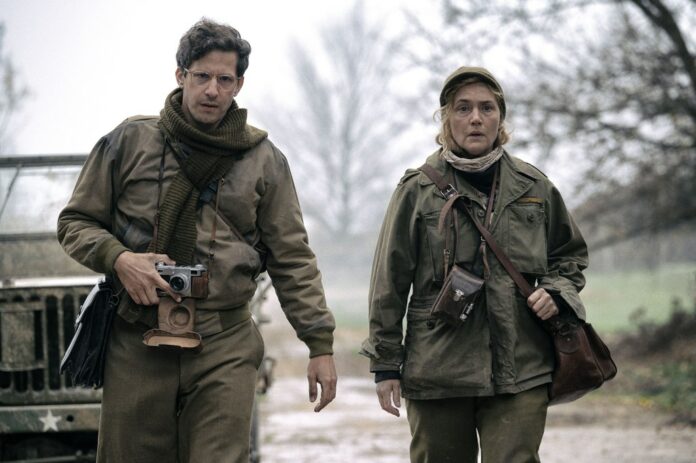
One of the animating questions in a film about a war correspondent is “why?” Why do they do what they do? It’s the primary question at the center of the new biopic “Lee,” about the famed photographer Lee Miller, who captured some of the most indelible images of the Holocaust as a war correspondent for Vogue during World War II. The question is posed by a young man (Josh O’Connor) interviewing a prickly Lee (Kate Winslet) about her life and work at her home in England in 1977, probing and provoking her in the hopes of extracting more profound answers than her usual caustic one-liners.
This framing device encircles just one remarkable chapter of the wild and colorful life of Lee Miller. Lee and this writer discuss a roughly 10-year period surrounding the war, but Miller lived so much life both before and after this era. An American model and fine art photographer, she had already been the muse and lover of Man Ray, and had taught photography in New York City. When we catch up with her in the late 1930s, she’s gallivanting around the south of France with her friends, the group blithely unaware of the horrors that await with the rise of Hitler. In just a few short years, Lee will find the purpose in her work that drives her, as well as traumas that almost destroy her.
Winslet, who produced “Lee” in addition to her starring role, has spent nine years developing the project, working with Antony Penrose, Miller’s son, and the author of the book “The Lives of Lee Miller.” Ellen Kuras, a lauded cinematographer, television director, and Oscar-nominated documentary filmmaker, makes her narrative feature directing debut on “Lee.”
Lee seeks out the women in war, not just because she’s often shut out of male spaces, but because she is compelled to, and it soon becomes one of her artistic and journalistic obsessions. Though Miller is often spoken about in the context of her famous romantic relationships, and Alexander Skarsgard plays her husband Roland Penrose, much of “Lee” is devoted to her working relationships and close friendships.
In addition to Marion Cotillard and Noémie Merlant, who play Lee’s French best friends, Andrea Riseborough co-stars as Audrey Withers, Lee’s editor and champion at Vogue, while Andy Samberg, in his first purely dramatic role, plays Davy Scherman, an affable New York photographer who becomes Lee’s professional partner as they report from war zones in France and Germany.
Samberg is a revelation here, delivering a terrifically subtle but incredibly moving performance. The powerful and daring Lee, a force of nature, has her own fears and vulnerabilities, and she finds comfort in Davy, a rare man who feels safe enough to trust. During the liberation of France in 1944, she hears of missing people and they drive deep into Germany at the very end of the war to uncover the ugly reality of the Holocaust, trusty Davy by her side as she relentlessly pushes forward in search of the truth.
“Lee” is anchored by a stunning extended sequence as Lee and Davy witness and document the wreckage and human destruction of Hitler’s regime: Nazi suicide pacts, piles of corpses, concentration camps, prisoners, victims. It slowly builds to the capturing of an iconic photo of Lee bathing in Hitler’s bathtub, one of the most famous images of her. In the context of the film it all makes perfect sense. After seeing the human toll of Hitler’s murderous wake, it seems apt to absurdly humiliate, or dominate Hitler in this specifically feminine way. In the film, Lee is both model and author of this image, and creating it is cathartic, leading to an emotional breakdown for Davy, delicately conveyed by Samberg. The flinty Lee remains stoic, speaking through her work, drowning her emotions in booze and pills.
This is a penetrating, revelatory biopic, and while it may take a familiar shape, the pioneering woman at the center was anything but traditional.
(“Lee” contains disturbing images, language and nudity)
“LEE”
Rated R. At the AMC Boston Common and suburban theaters.
Grade: B+


